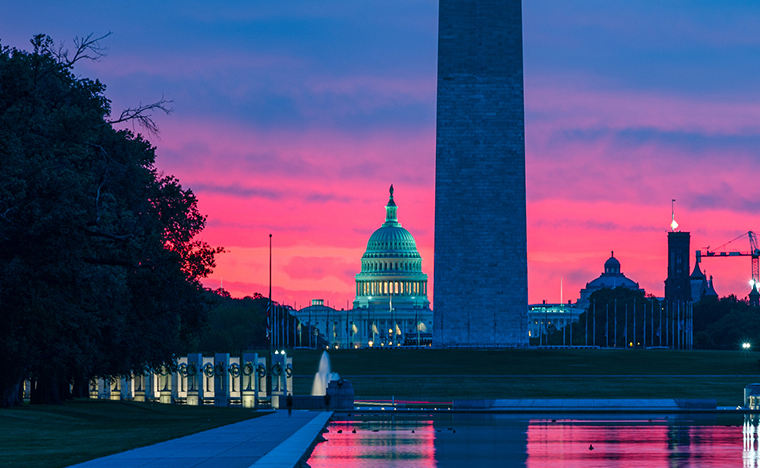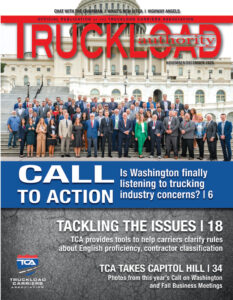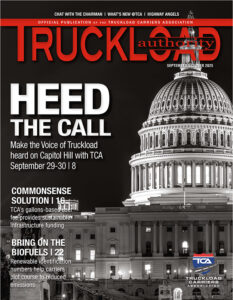Normally the Capitol Recap is filled with articles about new pieces of legislation and Congressional hearings. You might say this section of this issue is a potpourri of stories, ranging from the Department of Labor withdrawing a rule that could spell the end of the independent contractor model, to the Federal Highway Administration celebrating 50 years of bridge safety, to President Joe Biden’s nomination of Meera Joshi to become the next administration of the Federal Motor Carrier Safety Administration. There is definitely news on the legislative front, however, and because of the significant of those pieces of legislative we’ve chosen to cover those more in depth. Click here to read more about about legislative initiatives involving Automatic Emergency Braking, Speed Limiters, Liability Insurance Increase, and Truck Parking.
DOL WITHDRAWS ‘INDEPENDENT CONTRACTOR RULE’
The U.S. Department of Labor (DOL) has withdrawn the Independent Contractor Rule that was published during the final days of Donald Trump’s presidency.
When the DOL initially published the rule in the Federal Register on January 7, 2021, the agency noted that it was “revising its interpretation of independent contractor status under the Fair Labor Standards Act (FLSA) to promote certainty” for stakeholders, including the trucking industry, as well as in an effort to reduce litigation and “encourage innovation in the economy.”
The rule sought to define the difference between an employee and an independent contractor, noting, “The ultimate inquiry is whether, as a matter of economic reality, the worker is dependent on a particular individual, business, or organization for work (and is thus an employee) or is in business for him- or herself (and is thus an independent contractor).”
In a May 5 announcement, the DOL said the withdrawal of the rule would maintain workers’ rights to minimum wage and overtime compensation under the FLSA. In addition, the DOL cited the following reasons for the withdrawal of the January 7 Independent Contractor Rule:
- The independent contractor rule was in tension with the FLSA’s text and purpose, as well as relevant judicial precedent;
- The rule’s prioritization of two “core factors” for determining employee status under the FLSA would have undermined the long-standing balancing approach of the economic realities test and court decisions requiring a review of the totality of the circumstances related to the employment relationship; and
- The rule would have narrowed the facts and considerations comprising the analysis of whether a worker is an employee or an independent contractor, resulting in workers losing FLSA protections.
“By withdrawing the Independent Contractor Rule, we will help preserve essential worker rights and stop the erosion of worker protections that would have occurred had the rule gone into effect,” said U.S. Secretary of Labor Marty Walsh in the DOL’s May 5 announcement. “Legitimate business owners play an important role in our economy but, too often, workers lose important wage and related protections when employers misclassify them as independent contractors. We remain committed to ensuring that employees are recognized clearly and correctly when they are, in fact, employees so that they receive the protections the Fair Labor Standards Act provides.”
Because the Independent Contractor Rule was never implemented, its withdrawal should have negligible impact on the trucking industry.
“TCA was supportive of the Department’s final rule as it would have helped to ensure that trucking’s historically successful independent contractor model was protected by federal regulations,” shared TCA’s Vice President of Government Affairs David Heller. “We will continue to monitor the DOL’s activity related to independent contractor status for any signs that the Biden Administration plans to move in a more restrictive direction.”
FHWA COMMEMORATES 50 YEARS OF BRIDGE SAFETY
During the last week of April, the U.S. Department of Transportation’s Federal Highway Administration (FHWA) observed the 50th anniversary of its National Bridge Inspection Standards (NBIS), the basis for the federal program that helps protect nearly 620,000 bridges across the country.
“For a half-century, NBIS standards have been at the core of federal infrastructure safety efforts,” said Acting Federal Highway Administrator Stephanie Pollack. “The data we collect under the program help keep bridges safe and identify areas where maintenance is needed before problems arise.”
The number of bridges in the NBIS program has grown from 588,735 to 618,456 — that’s nearly 30,000 new bridges — over the past 20 years, and the program has continued to ensure these bridges are safe for those who rely on the structures for travel and commerce.
Less than one month after the celebration, an Arkansas Department of Transportation inspection found a fractured beam in the Mississippi River bridge between Arkansas and Tennessee, shutting down the bridge for an undetermined amount of time.
The NBIS requires regular and thorough inspections of highway bridges by trained inspectors to detect potential structural problems early and to ensure maintenance efforts are being performed. State departments of transportation inspect bridges, on average, once every 24 months and report the results to FHWA. If a bridge is rated as potentially unsafe, immediate actions are taken, which could include closure, prompt repairs, or load posting to restrict use by heavy vehicles.
In addition to specialized training for bridge inspectors, the program also requires the collection of bridge condition data for inclusion in FHWA’s National Bridge Inventory (NBI), which helps transportation officials make informed decisions about funding priorities.
“The NBIS is vital to bridge safety in our nation,” added Pollack. “The (Biden) administration’s American Jobs Plan proposes significant investment in our nation’s bridges to continue improve their condition and make them even safer.”
FHWA officially adopted the NBIS regulations in 1971 after the collapse of the Silver Bridge in West Virginia. The bridge collapsed into the Ohio River in 1967 because of a crack in the bridge’s suspension chain. The tragedy, which took the lives of 46 people, brought national attention to the issue of safe bridge conditions and led to a systematic effort to ensure oversight at the national level.
Since the program’s inception, FHWA has worked to update training requirements for bridge inspectors and replace narrative bridge inspection summaries with specific assessment criteria to improve consistency.
According to a statement from the FHWA, President Joe Biden’s American Jobs Plan would provide an additional $115 billion to modernize the bridges, highways, roads, and main streets that are in most critical need of repair. It would also fix 10 significant bridges in need of reconstruction and repair the worst 10,000 smaller bridges to reconnect communities across the country.
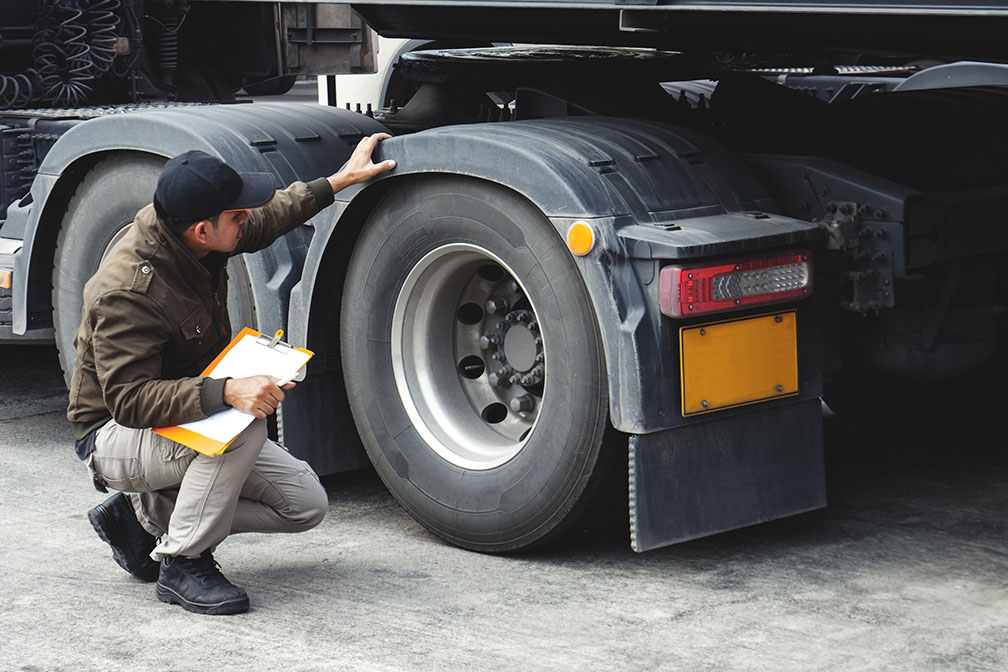
CVSA’S BRAKE SAFETY WEEK SET FOR AUGUST 22-28
The Commercial Vehicle Safety Alliance’s (CVSA) annual Brake Safety Week is scheduled for August 22-28. During Brake Safety Week, commercial motor vehicle inspectors emphasize the importance of brake systems by conducting inspections and placing commercial motor vehicles found to have brake-related violations out of service. At the same time, many motor carriers work to educate their drivers and maintenance service providers on the importance of brake system safety.
In addition to brake inspections, inspectors will compile data on brake hoses and tubing to submit to CVSA. Findings will be reported later this year.
Jurisdictions devote a week to conducting commercial motor vehicle inspections, identifying brake violations, and removing vehicles with out-of-service brake violations because:
- Brake system and brake adjustment violations accounted for more vehicle violations than any other vehicle violation category, accounting for 38.6% of all vehicle out-of-service conditions during last year’s three-day International Roadcheck inspection and enforcement initiative.
- “Brake system” was the third most cited vehicle-related factor in fatal commercial motor vehicle and passenger vehicle crashes, according to the Federal Motor Carrier Safety Administration’s (FMCSA) latest “Large Truck and Bus Crash Facts” report.
- Brake-related violations accounted for eight out of the top 20 vehicle violations in 2020, according to FMCSA’s Motor Carrier Management Information System.
- During last year’s Brake Safety Week, 12% of the 43,565 commercial motor vehicles inspected were placed out of service for brake-related violations.
The dates for Brake Safety Week are shared in advance to remind motor carriers, drivers, and commercial motor vehicle mechanics/technicians to proactively check and service their vehicles to ensure every commercial motor vehicle is safe, mechanically fit, and compliant. Recent research has shown that announcing enforcement campaigns ahead of time improves overall compliance better than surprise enforcement campaigns and for longer periods after the event.
CVSA’s Brake Safety Week falls during Brake Safety Awareness Month. Law enforcement agencies will work to educate commercial motor vehicle drivers, motor carriers, mechanics, owner-operators, and others on the importance of proper brake maintenance, operation, and performance through outreach, education, and awareness campaigns.
MEERA JOSHI NOMINATED TO BE NEXT FMCSA ADMINISTRATOR
President Joe Biden has nominated Meera Joshi as administrator of the Federal Motor Carrier Safety Administration.

Since January 20, 2021, Joshi has served as the agency’s deputy administrator and senior official.
Joshi, an attorney, has more than 16 years of experience in leading government oversight agencies. She served as chair and CEO of the New York City Taxi and Limousine Commission, the nation’s largest for-hire transportation regulator. While there, she spearheaded novel Vision Zero campaigns using data tools to keep high-risk drivers and unsafe vehicles off the road. She also led landmark policy, including establishing robust open transportation data standards for app-based providers; enacting the nation’s first for-hire driver pay protection program; and providing broad access to for-hire transportation for passengers who use wheelchairs.
Before entering the field of transportation regulation, Joshi was the inspector general for New York City’s Department of Corrections, where she was responsible for the investigation of corruption and criminality at all levels of New York City’s jail operations. Joshi also served as the first deputy executive director of New York City’s Civilian Complaint Review Board, leading investigations of police misconduct.
In addition to her government positions, Joshi has served as general manager for the New York office of Sam Schwartz Transportation Consultants and was a visiting scholar at New York University’s Rudin Center for Transportation Policy. Joshi was born and raised in Philadelphia. She holds a Bachelor of Arts degree and a Juris Doctor from the University of Pennsylvania.
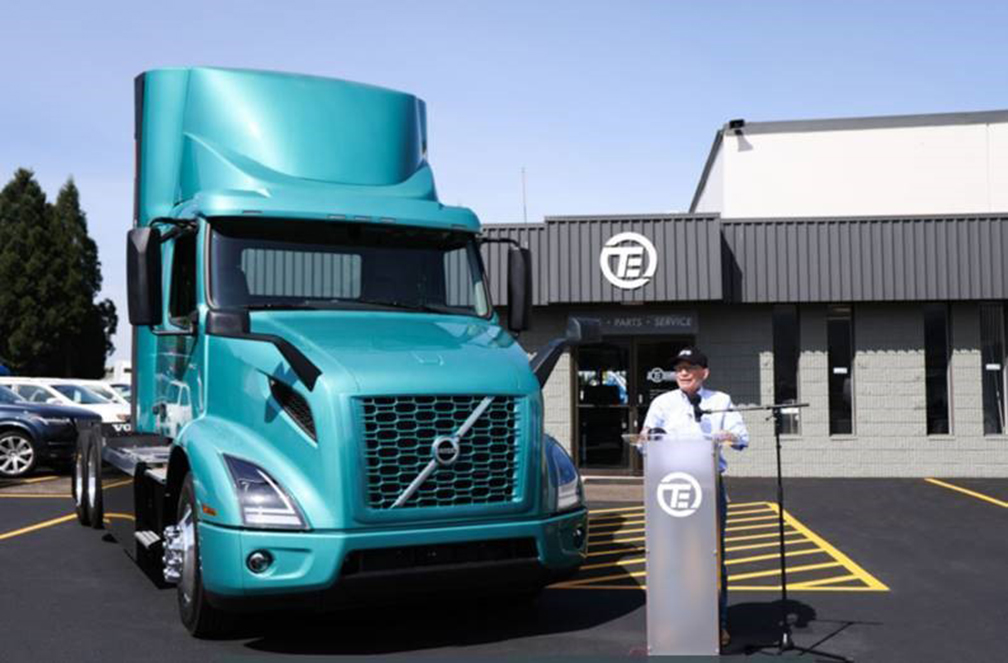
DEFAZIO HIGHLIGHTS NEED FOR CLEAN ENERGY DURING TEST-DRIVE OF VOLVO ELECTRIC TRUCK
In early May, Rep. Peter DeFazio (D-OR-4), Chair of the House Committee on Transportation and Infrastructure, visited Volvo Trucks North America’s TEC Equipment dealership location in Coburg, Oregon, to test-drive an electric Volvo Class 8 truck and highlight his clean energy priorities.
“For years, climate change deniers have argued that big businesses would never choose to invest in clean technologies because it wouldn’t make business sense — but now, big corporations are showing that there is a business case for climate solutions,” said DeFazio. “As I work with President Biden to move the American Jobs Plan through Congress, I look forward to making investments that move our country toward cleaner, greener technologies and a zero-pollution transportation sector. It’s a plan that addresses the existential threat of climate change and creates thousands of good-paying jobs and strengthens an economy reeling from the COVID-19 pandemic.”
During the visit, DeFazio was joined by TEC Equipment’s Founder and CEO Dave Thompson; Oregon Department of Energy’s Assistant Director for Planning and Innovation Alan Zelenka; Forth Mobility’s Executive Director Jeff Allen; and Volvo Group North America’s Senior Vice President of Public Affairs Jonathan Miller
“At Volvo Group North America, we are committed to electrification and many other efforts to support the decarbonization of transportation and sustainability of our environment, including the launch of the Volvo VNR Electric Class 8 truck model, as demonstrated in Coburg, Oregon,” said Miller. “Last year, the Volvo Group announced plans in line with the Paris Agreement to be fossil-fuel free by 2040. While these are ambitious goals, we are currently taking orders and delivering on our plans to commercially launch battery-electric trucks, buses and construction equipment in the United States and Canada.”
The Volvo VNR Electric truck is designed for driving cycles with both local and regional
distribution ranges, including food and beverage and pick-up and delivery routes. According to the manufacturer, the truck’s batteries can charge up to 80% within 70 minutes and have an operating range of up to 150 miles, based on the truck’s configuration.
DeFazio is expected to be a principal author and negotiator of President Biden’s American Jobs Plan, a wide-sweeping proposal aimed at fixing and modernizing the nation’s outdated infrastructure system, according to a prepared statement from DeFazio’s office. DeFazio said he plans to introduce legislative text that lays out transformative investments in roads, bridges, transit, and rail, consisting of funding to help build charging capacity to accommodate the shift to electric vehicles, including passenger vehicles, freight trucks, and buses.
The statement cites the Business Roundtable, noting that inadequate infrastructure costs U.S. businesses $27 billion per year in extra transportation costs. According to the American Society of Civil Engineers, between 2016 and 2025, the economy will lose almost $4 trillion in economic activity if there are not upgrades to the nation’s infrastructure, which could cost 2.5 million jobs.
STATES GO SLOW ON ROAD TAXES
Raising state taxes to improve roads and bridges is one of the few things many Republican and Democratic lawmakers have agreed on in recent years.
Those efforts have slowed this year, even as lawmakers acknowledge a widening gap between needed work and the money to pay for it. One reason is the federal response to the COVID-19 pandemic.
Some states are “waiting to see what direction the federal government is going to be taking,” said American Road and Transportation Builders Association’s Advocacy Director Carolyn Kramer.
State lawmakers across the country have proposed fewer than 170 transportation funding bills this year — barely half the amount proposed during the last post-election year of 2019, according to the association. So far, not a single transportation tax increase has passed, though several are pending.
Kramer said states are still assessing the effects of the pandemic on their economies, but also are watching for a potential gusher of federal money. Numerous avenues exist for new federal road funding, including the following:
- President Joe Biden signed a coronavirus relief package that includes $350 billion for state and local governments. Some states, such as Indiana and Maryland, already are planning to spend part of that on transportation projects; others are awaiting federal guidance on using the money.
Biden has also proposed at least $115 billion for roads and bridges as part of a $1.7 trillion infrastructure plan. Senate Republicans have countered with a $928 billion infrastructure plan that would dedicate $506 billion to roads and bridges;
- Congress is working on a long-term renewal of the nation’s main highway program that could direct billions more annually to states; and
- The American Association of State Highway and Transportation Officials has urged Congress to essentially double existing funding, with a $200 billion road-and-bridge stimulus, plus an additional $487 billion in a five-year highway program.
The proposals could add up to more federal road-and-bridge aid than at any time in recent years.
“It looks like a cruise ship sitting in a pond — that’s how much money we’re getting flowing into the state of Colorado from the federal government,” said Colorado state Sen. Ray Scott (R-7). “If Biden does get this pushed through and we have additional funding coming our way, why would we go after the taxpayer when we have ways we can handle it right now?”
While Scott wants to base any transportation plan on an influx of federal money, Colorado’s Democratic Gov. Jared Polis and the state’s Democratic legislative leaders want to raise fees on gasoline sales, electric and hybrid vehicles, ride-sharing companies and retail delivery services.
“Colorado’s transportation system is so far behind that we need federal investment and we need state-level investment,” said state Sen. Faith Winter (D-24).
Colorado’s gas tax has remained unchanged since 1991, while per capita spending on transportation has fallen by almost half. The new funding plan has yet to receive a legislative hearing, though Democratic lawmakers could still speed it through if they desire.
Bills to raise gas taxes already have failed this year in Arizona, Kentucky, Mississippi, and Wyoming.
After the North Dakota House passed a 3-cent gas tax increase, the Senate solidly defeated it. The legislature instead passed a $680 million infrastructure bonding plan aimed primarily at flood-control projects that also includes $70 million for roads and bridges. The bonds will be repaid with earnings from the state’s oil tax savings account.
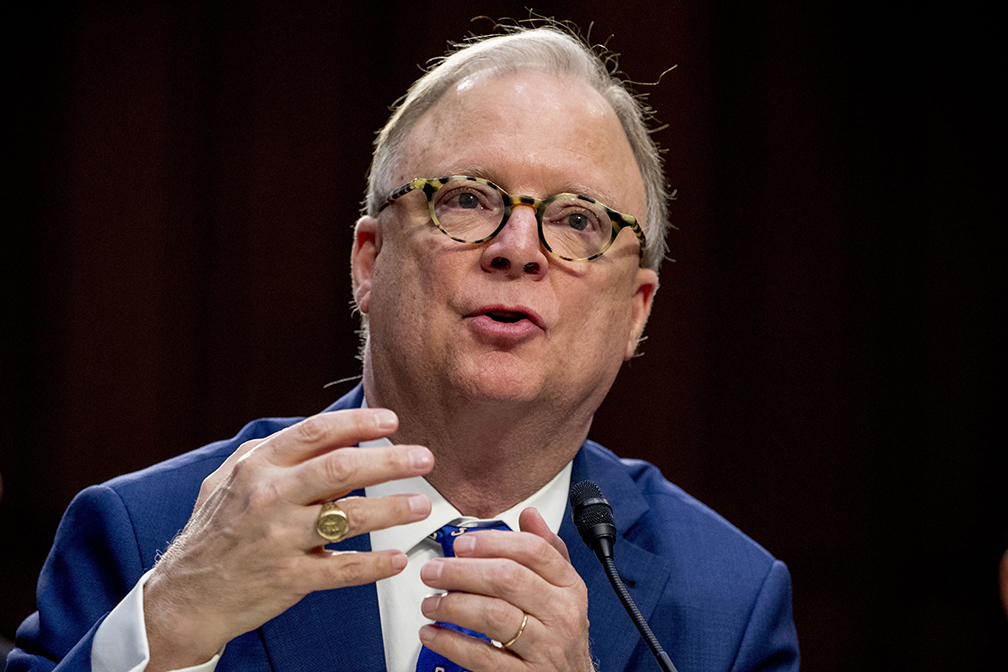
NTSB CHAIRMAN ROBERT SUMWALT STEPS DOWN
A spokesman for the National Transportation Safety Board (NTSB) said Robert Sumwalt stepped down from his position as NTSB chairman effective June 30.
The spokesman, who called Sumwalt a “great chairman” said Sumwalt notified NTSB employees of his intention in an email delivered in mid-May.
The Associated Press (AP) reported that the Biden administration was expected to nominate a fellow board member to replace Sumwalt, who had served as chairman of the board since 2017.
The former commercial pilot and commercial aviation executive had served in various positions on the board, beginning in 2006 during the George W. Bush administration.
The federal agency is charged by Congress to conduct independent probes of transportation accidents and can make urgent or longer-term safety recommendations to address issues discovered during an investigation.
The AP reported that Sumwalt was expected to be replaced by Jennifer Homendy, a board member who served as the agency’s public face following the helicopter crash that killed basketball legend Kobe Bryant. However, the source for this information was not authorized to discuss the matter publicly and
spoke to the AP on condition of anonymity.
Homendy, whose nomination would be subject to congressional approval, has served as a board member since 2018. She had previously worked as a staff director for a House subcommittee.
Sumwalt was sworn in as the 14th chairman of the NTSB on August 10, 2017, after being nominated by President Donald J. Trump and confirmed by the Senate. He was reappointed as chairman by Trump in August 2019, after being unanimously confirmed by the Senate. Sumwalt began his tenure at the NTSB in August 2006 when Bush appointed him to the board and designated him as vice chairman. In November 2011, President Barack Obama reappointed Sumwalt to an additional five-year term as board member.
Before joining the NTSB, Sumwalt was a pilot for 32 years, including 24 years with Piedmont Airlines and US Airways. He accumulated over 14,000 flight hours. During his tenure at US Airways, he worked on special assignment to the flight safety department and served on the airline’s Flight Operational Quality Assurance monitoring team.
LARGE TRUCKS ARE INVOLVED IN 1/3 OF ALL FATAL CRASHES OCCURRING IN WORK ZONES
The Federal Motor Carrier Safety Administration (FMCSA) has called on all drivers to “share work zone safely” by staying alert, obeying traffic signs, and allowing all vehicles extra space.
“Fatal crashes occurring in work zones are both tragic and absolutely preventable,” said FMCSA Deputy Administrator Meera Joshi. “I am especially concerned that large trucks continue to have a disproportional involvement in fatal crashes occurring in work zones — 33% — when large trucks comprise roughly 5% of vehicular traffic. Don’t allow yourself to become distracted, slow down, obey the signs and the instructions of flaggers, and be courteous and safe by giving every vehicle extra space. Highway workers equally depend on you for their safety.”
The Federal Highway Administration (FHWA) reports that in 2019, the most recent available data, 842 people died in highway work zone crashes compared to 757 the year before. The 11.2% increase is the largest percentage increase of highway work zone fatalities this century.
For its part in supporting National Work Zone Awareness Week, FMCSA concentrated its safety awareness efforts in Florida, Georgia, and Texas, which experience some of the highest rates of work zone crashes involving large trucks. In those states, motorists can expect to hear public service announcements and see safety messaging on billboards as they approach work zones.
Through the FMCSA’s Our Roads, Our Safety initiative, the agency has developed educational resources, including fact sheets, postcards, and shareable social media infographics for safety advocates to help amplify work zone messaging. Arkansas, Oklahoma, and Pennsylvania — also states that have a high number of fatal crashes in work zones each year — will be conducting special activities such as holding educational workshops for commercial vehicle drivers and placing safety signage at weigh stations.
As an Our Roads, Our Safety partner, the Truckload Carriers Association actively promotes and encourages its membership to share informative resources, PSAs, and social media content. To learn more or to access shareable graphics, visit truckload.org/FMCSA-Our-Roads-Our-Safety-Initiative.
The Truckload Authority News Staff, comprised of award winning journalists and graphic artists, produces content for Truckload Authority, working in cooperation with the Truckload Carriers Association staff. Truckload Authority aims to keep TCA members abreast on the latest trends in the trucking industry as well as articles that feature TCA member executives and drivers. The Truckload Authority staff is based in Little Rock, Arkansas.








